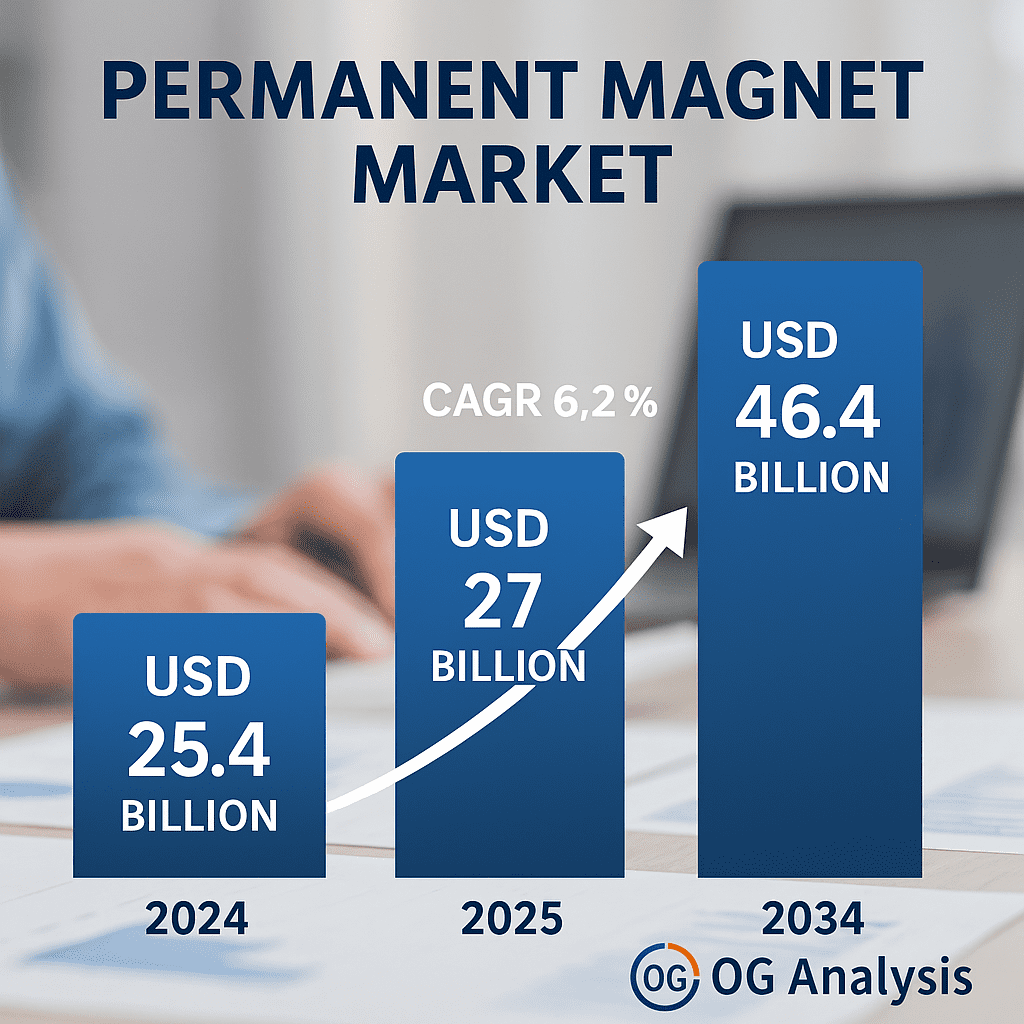Is the Permanent Magnet Market Attracting the Next Wave of Tech-Powered Growth?
As global industries shift toward electrification, automation, and sustainable energy, permanent magnets have become a cornerstone of innovation. From powering electric vehicles to enhancing efficiency in wind turbines and industrial motors, their role is more vital than ever. According to OG Analysis, the Permanent Magnet Market is valued at USD 25.4 billion in 2024, set to grow to USD 27 billion in 2025, and projected to reach USD 46.4 billion by 2034 at a CAGR of 6.2%.
1. Why Are Permanent Magnets So Critical in a High-Tech Economy?
Permanent magnets—particularly neodymium-iron-boron (NdFeB) and samarium cobalt—are at the heart of the modern energy transition. They are widely used in electric motors, sensors, medical devices, and wind turbines, offering high magnetic strength with minimal energy loss. As industries prioritize performance and energy efficiency, demand for these rare-earth magnets is surging across applications.
2. Are Neodymium Magnets Leading the Charge in Electric Mobility?
Yes. Neodymium-based magnets are the preferred choice for electric vehicle (EV) motors, owing to their strong magnetic field and resistance to demagnetization. With EV production accelerating globally, this segment is a major demand driver. Companies like TDK Corporation and DAIDO STEEL CO., LTD. are ramping up production and R&D to meet the demands of automakers and clean energy players alike.

3. How Are Ferrite Magnets Evolving Amid the Rare Earth Supply Challenge?
Ferrite magnets, especially sintered and bonded ferrite types, offer a cost-effective alternative to rare-earth magnets. While they have lower magnetic strength, they are highly stable and corrosion-resistant, making them ideal for automotive components, industrial systems, and consumer appliances. Innovations in soft and semi-hard ferrite types are helping balance performance and affordability.
You can Directly Purchase the Report Here:
4. Which Regions Are Dominating Production and Demand in 2025?
The Asia-Pacific region, led by China, India, and Japan, continues to be the manufacturing and consumption powerhouse for permanent magnets. China, in particular, holds a dominant position due to its abundant rare-earth reserves and advanced refining capabilities. Meanwhile, Europe and North America are scaling up domestic magnet supply chains to reduce import dependency, especially for high-performance applications in automotive and renewable energy sectors.
5. What Opportunities Are Emerging in the Energy & Power Sector?
Permanent magnets are playing a key role in the transition to renewable energy, especially in wind turbine generators and high-efficiency power tools. With global policies supporting green energy initiatives, the energy & power sector presents one of the most lucrative opportunities for magnet manufacturers. Companies are exploring high-temperature-resistant magnet materials to improve performance and durability in harsh operating conditions.
6. How Are End-Use Industries Shaping Material Demand?
- Electronics & Appliances: Increasing miniaturization and performance needs are pushing the demand for compact, powerful magnets.
- Automotive: From EV traction motors to sensor applications, permanent magnets are central to modern vehicle engineering.
- Medical: MRI machines, implants, and surgical tools rely on precision magnet technology.
- Industrial: Automation and robotics are driving demand for smart, efficient magnet-powered components.
Each end-use segment is influencing the adoption of different magnet materials and manufacturing processes, offering opportunities for specialization and innovation.
7. What Are Market Leaders Doing to Stay Ahead?
Key players like Arnold Magnetic Technologies, JPMF Guangdong Co., Ltd, and PROTERIAL, Ltd. (Hitachi Metals) are investing in advanced magnetic materials, eco-friendly production, and regional manufacturing hubs to de-risk supply chains. Strategic collaborations, particularly in EV and wind energy sectors, are helping these firms lock in long-term demand while accelerating innovation.
You can Directly Purchase the Report Here:
Key Segments of the Permanent Magnet Market Driving Opportunities and Innovations?
By Material:
Neodymium-Iron-Boron
Ferrite
Samarium Cobalt
Alnico and Other
By Ferrite Process:
Sintered Ferrite Magnet
Bonded Ferrite Magnet
By Ferrite Type:
Hard Ferrite
Semi-Hard Ferrite
Soft Ferrite
By End-Use:
Electronics & Appliances
Automotive
Industrial
Energy & Power
Medical
Other
By Geography:
North America (USA, Canada, Mexico)
Europe (Germany, UK, France, Spain, Italy, Rest of Europe)
Asia-Pacific (China, India, Japan, Australia, Rest of APAC)
The Middle East and Africa (Middle East, Africa)
South and Central America (Brazil, Argentina, Rest of SCA
Browse through More Reports Similar to the Global Wood packaging Market 2025, By the OG Analysis:
Epoxy Curing Agents Market Analysis and Outlook Report:
Hydrogen Sulfide Scavengers Market Analysis and Outlook Report:
Final Takeaway:
The Permanent Magnet Market is no longer just a supplier to electronics—it’s now a strategic enabler of the green energy revolution, mobility innovation, and next-gen automation. With a projected market size of USD 46.4 billion by 2034, and strong traction across key sectors and regions, permanent magnets are becoming the invisible force behind some of the world’s most transformative technologies.
Stay tuned with OG Analysis for more insights into how advanced materials like permanent magnets are shaping the future of smart, sustainable industries.
Connect with us on:
LinkedIn: XXX
Twitter: XXX
YouTube: XXX
Contact Us
+91 888 64 99099
Email: mailto:sales@oganalysis.com
Learn More about OG Analysis
OG Analysis, established in 2009 has 14+ years of experience and served 1800+ clients from 980+ companies operating in 54+ countries. OG Analysis is a leading provider of market research reports in Chemicals, Energy, Oil & Gas, Food & Beverage, Electronics & Semiconductors, Automotive, Telecommunication, Healthcare and Other industries.